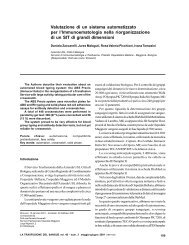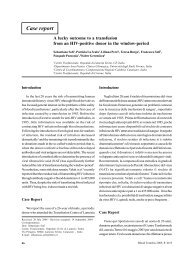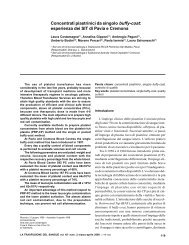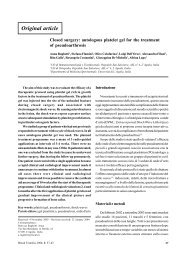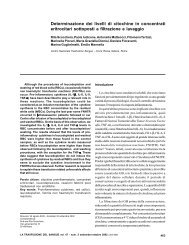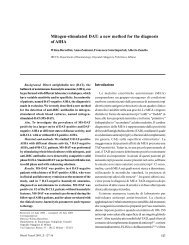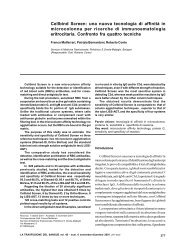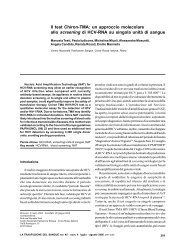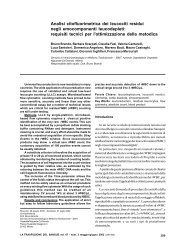Bocciardo L et alTable IV - Consumption of plasma derivatives by the Gaslini InstituteConsumption of Consumption of Consumption ofalbumin intravenous IgG antithrombin III2001 38,580 g 6,024 g 405,000 UI2002 34,190 g 8,445 g 386,000 UI2003 43,290 g 7,830 g 388,000 UI2004 44,000 g 6,476 g 550,000 UI2005 43,762 g 8,579 g 530,500 UITable V - Theoretical coverage of the requirements of plasma derivatives2001 2002 2003 2004 2005Albumin 82.62% 97.47% 79.18% 84.32% 91.63%Intravenous IgG 61.38% 45.78% 50.78% 66.45% 54.22%Antithrombin III 23.94%% (with reference to 2001)1601401201008060402002001 2002 2003 2004 2005YearAlbuminIntravenous IgGAntithrombin IIITotalFigure 5 - Requirements for albumin, intravenous IgG <strong>and</strong> antithrombin III, normalised to 2001 levels. Thevirtual overall requirements, calculated as the sum of the three products, is also reported, againnormalised to 2001 levelsantithrombin III was distributed after third party processingstarting from March of the same year.Finally, for each blood derivative considered, weevaluated the amount of plasma necessary to meet thetheoretical requirements.The graph in figure 6 shows the trends in the amountsneeded for each of these derivatives each year.It is clear from this that the blood derivative giving riseto the greatest request for plasma is intravenous IgG.DiscussionIn line with the national plan for reaching selfsufficiencyin plasma derivatives, the SIMT of the GasliniInstitute for children defined a plan to increase the volumeof plasma to send for industrial fractionation as an objectiveof its Quality System. This led to the definition of newprocedures for both production <strong>and</strong> clinical use of plasma.The increase in plasma production was obtainedwithout compromising the primary objective of the SIMT90<strong>Blood</strong> Transfus 2007; 5: xx-xx DOI 10.2450/2007.0033-06085-92_bocciardi.p65 9009/07/2007, 9.47
Plasma derivative self-sufficency in Liguria35003000Litres of plasma2500200015001000500AlbuminIntravenous IgGAntithrombin III02001 2002 2003 2004 2005YearFigura 6 - The number of litres of plasma necessary to meet the dem<strong>and</strong>s for albumin, intravenous IgG <strong>and</strong>antithrombin III over the years studiedof maintaining self-sufficiency to meet needs for red cellconcentrates, but rather by optimising the type of donationon the basis of the users' characteristics. The increase inplasma from apheresis in 2002 was due to the increase indonations made with a cell separator. In 2003, theintroduction of multicomponent donations of plasma <strong>and</strong>platelets led to a further increase in the volume of class Aplasma, without having to increase the number ofdonations.In September 2006, the technique of collecting highconcentrationplatelet concentrates during multicomponentdonations was introduced. It is estimated that thistechnique will further increase the production of categoryA plasma by about 400 litres/year. In addition, consideringthat about 25% of the units of plasma are assigned to lowweight patients, the use of paediatric units of 50 mL (unitsfor clinical use are currently fractioned into subunits of100-150 mL) will not only further reduce the risk of<strong>transfusion</strong>s (by enabling plasma from the same donor tobe used for more than one <strong>transfusion</strong>) but also save anestimated volume of more than 40 litres of plasma eachyear.The implementation of shared guidelines on the use ofthe blood components has, finally, allowed the clinical useof the plasma collected to be kept under control.Although the production of plasma has increasedconsiderably in the last few years, it is not yet sufficient tomeet the Institute's requirements for blood derivativeswhich are, in fact, guaranteed by the policy of the CRCC.The consumption of blood derivatives in our Instituteis high because the patients are children <strong>and</strong> because itcontains numerous highly specialised wards. The highconsumption of plasma derivatives is only partly undercontrol, because of the lack of agreed guidelines within theInstitute. However, the introduction of regional guidelineson the use of albumin in 2002 may have contributed to thefact that there was a relatively limited increase in theconsumption of albumin, in the three years 2003-2005. Onthe other h<strong>and</strong>, the use of intravenous IgG has alwaysbeen such that the theoretical coverage of needs is poor. Arecent review of the literature 2 showed that the number ofpublications on the use of intravenous IgG continues toincrease rapidly, although in reality there is little evidenceobtained from r<strong>and</strong>omised, controlled clinical trials. Thishas led to a notable increase in off-label prescriptions,estimated, by the Food <strong>and</strong> Drug Administration, to accountfor between 50% <strong>and</strong> 70% of all prescriptions, even inorganisational settings such as in America, in which theuse of guidelines is consolidated 2 . Although the increasein the consumption of intravenous IgG is also due to theexp<strong>and</strong>ed indications for use in a certain number of clinicalconditions, it is clear that the Institute must implement anagreed document regulating the use of this product. Theincreased consumption of immunoglobulins is aphenomenon present nationwide; our data do not, therefore,reflect the fact that our Institute cares for paediatricpatients, but rather confirm the change in the 'drivingproduct', already noted by other researchers 3 . Theconsumption of albumin is now no longer significantlygreater than that of the other plasma derivatives 4-6 , such<strong>Blood</strong> Transfus 2007; 5: xx-xx DOI 10.2450/2007.0033-0691085-92_bocciardi.p65 9109/07/2007, 9.47



